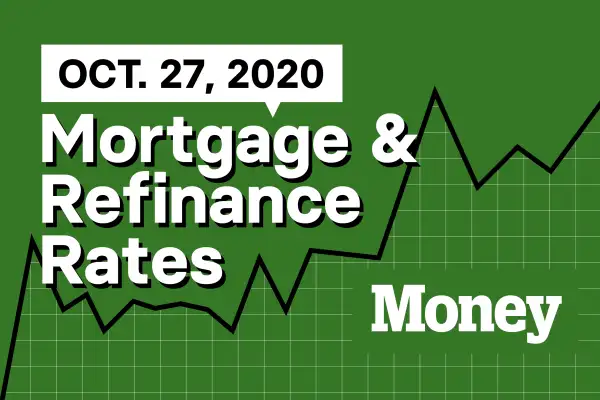Here Are Today's Best Mortgage & Refinance Rates for October 27, 2020

The average rate for a 30-year fixed-rate purchase mortgage was 3.567% on Monday. The average rate for a 30-year refinance was 4.348%.
Money's current mortgage rates include data from over 8,000 lenders across the United States and are updated daily. These rates include discount points and represent what a borrower with a 20% down payment and 700 credit scores — roughly the national average FICO score — would have been quoted.
| 30-year fixed-rate purchase mortgage |
| 3.567% |
| Rate of October 26, 2020 |
Mortgage rates vary from state to state. On Monday, borrowers in Illinois were quoted the lowest mortgage rates — at 3.276%. People looking for mortgages in Nevada saw the highest average rate at 3.828%. Nationwide, borrowers with the highest credit scores, 740 and above, were quoted rates averaging 3.05%, while those with credit of 640 or below were shown rates of 4.763% — a 1.713 percentage-point spread.
You may be able to negotiate a lower rate if you shop around or if you have other accounts with the lender. (Money's picks for the best mortgage lenders are here.) Currently, some banks are hiking up advertised rates to keep demand in check, so you may be offered a lower rate if you reach out directly.
Freddie Mac's widely quoted Primary Mortgage Market Survey put rates at 2.80% with 0.6 points paid for the week ending October 22, a new record low. The mortgage purchaser's weekly survey reflects borrowers who put 20% down on conforming loans and have excellent credit.
Refinance rates today
Money's survey also shows that the offered rate for a 30-year refinance for someone with a 740 credit score was 3.777% on Monday. Last October, the average mortgage rate (including fees) was 3.859%.
| 30-year fixed-rate mortgage refi |
| 3.777% |
| Rate of October 26, 2020 |
A homeowner with a $200,000 mortgage balance currently paying 3.859% on a 30-year could potentially cut their monthly payment from $939 to $929 by financing at the current lower rates. To determine if it's worth it to refinance your mortgage, also consider the closing fees you paid on your current mortgage, how much your new lender is charging and how long you have left on your loan term. (Our picks for the best lenders for refinancing are here).
What else is happening in the housing market right now?
Sales of newly built single-family homes reached a seasonally adjusted annual rate of 959,000 units in September, according to the U.S. Census Bureau and the Department of Housing and Urban Development. Though a slight 3.5% drop from August rate, that's still 32% more new homes than sold in September 2019.
"New home sales can be quite volatile and September’s decline does not necessarily signal a cooling in the pace of home sales. We gauge the trend using a 3-month moving average and that rose to a 14-year high of 973,000," commented Tednayi Kapfidze, chief economist for LendingTree. "Unlike existing homes sales, new sales are running well ahead of 2019 sales and were barely impacted by COVID-19 earlier in the year."
The median price of a new home sold in September was $326,800, up from $315,700 last year. A recent increase in the cost of lumber, high buyer demand, and a limited supply of existing homes has led to the increase in the price of new homes.
"The pace of new home sales growth over the summer was going to slow given that the gap between sales and single-family construction reached an all-time high in August," said Robert Dietz, chief economist for the National Association of Homebuilders. "Indeed, September sales of new homes that had not started construction were up 47% compared to a year ago."
The seasonally adjusted estimate of new houses for sale at the end of September was 284,000 units, representing a 3.6 month supply at the current pace of sales. Though a slight improvement from August, inventory is still about 32% lower than August 2019. Of the total inventory available for sale, only 48,000 units have been completed and are ready to be lived in. More construction will be needed to fill in the sizeable gap between supply and demand.
Meanwhile, after two weeks of significant drops in the number of mortgage loans in forbearance, the number of borrowers exiting the payment deferral plans slowed. According to the Mortgage Bankers Association, the total share of loans in forbearance ticked down 2 basis points to 5.90% of all mortgage loans.
The share of Fannie Mae and Freddie Mac loans in the plans dropped for the 20th week in a row to 3.72%. Depository servicers also saw a decrease in the number of loans in forbearance. However, all other loan types saw slight increases.
"This is further evidence of the unevenness in the current economic recovery. The housing market is booming, as shown by the extremely strong pace of home sales last week," said Mike Fratantoni, chief economist for the MBA. "However, many homeowners continue to struggle, as the pace of the job market's improvement has waned."
Mortgage Prediction of the Week
Expert views on what comes next.
Ralph McLaughlin, chief economist at financial technology firm Haus, on the potential for a foreclosure crisis:
We’re expecting a widespread rise in foreclosure rates for two reasons. First, there is uncertainty over whether the forbearance program that is currently in place will last long enough to keep up with the vast levels of unemployment that American homeowners are facing. If forbearance isn’t renewed after 12 months and a large share of homeowners are still unemployed, we may see foreclosures and distressed sales rise enough to put downward pressure on home prices.
Second, with little advance in the way of a vaccine or herd immunity, it’s possible the virus will be with us next year as well. And if federal unemployment insurance isn’t renewed, unemployed persons will have trouble making payments, which could lead to even more distressed homes coming onto the market. The scariest outcome would be a scenario where the market realizes both of these outcomes. If so, the housing market could begin to act as an anchor, and not the sail it should be, for the economy."
For more of what the future looks like for foreclosures, read: Are We Headed for Another Foreclosure Crisis? 9 Housing Experts Share Their Predictions.
Bottom line:
Savvy Homebuyers Are Using an Under-the-Radar Strategy to Win Bidding Wars in 2020
New Construction Home Sales Are Soaring, but Financing a Purchase Can Be Tricky
Are We Headed for Another Foreclosure Crisis? 9 Housing Experts Share Their Predictions
Rates are subject to change. All information provided here is accurate as of the publish date.

